- Author Jason Gerald [email protected].
- Public 2024-01-19 22:11.
- Last modified 2025-01-23 12:04.
A wrist sprain is an injury to the ligament that connects the short bones in the wrist (carpal bones). The ligament most commonly injured in the wrist is called the scapho-lunate ligament, which connects the scaphoid bone to the lunate bone. The severity of a wrist sprain varies according to the severity of the stretch or tear of the ligament. The severity will determine how to treat it at home, or whether you need professional medical help.
Step
Part 1 of 3: Treating Minor Wrist Sprains
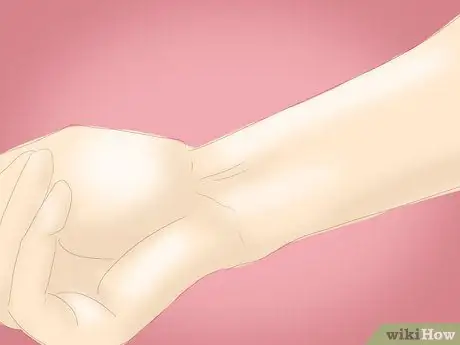
Step 1. Rest your wrist and be patient
Minor sprains are often the result of repeated use or over-extension of the joint from a fall with the arm outstretched. Try resting your wrist from repeated use if you suspect this is the cause. Talk to your boss at work about changing your activities for about a few weeks. If the wrist sprain is related to sports activities, this may be due to overexertion or incorrect technique, consult your personal trainer.
- Minor sprains of the wrist are often classified as grade 1 sprains, which are ligaments that are stretched a little too long, but not too much.
- Common symptoms of a grade 1 sprain are pain that can be endured, mild inflammation or swelling, resistance to movement, and reduced wrist strength.
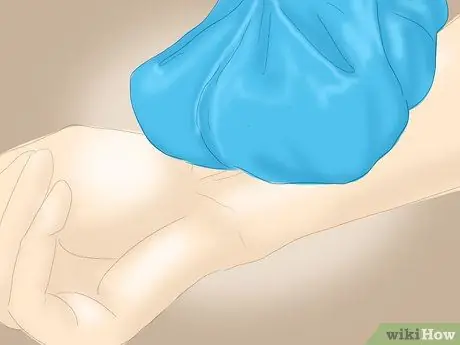
Step 2. Apply an ice pack to the wrist
Ice is an effective treatment for almost all muscle and bone injuries, including wrist sprains. Apply ice to the area of your wrist that hurts the most to reduce pain and swelling. You can apply ice for 10-15 minutes every 2-3 hours for a few days then reduce the frequency as the pain and swelling decrease.
- Applying ice to the wrist with an elastic bandage can also help control inflammation. However, don't tie the bandage too tightly as the blocked blood flow can exacerbate injuries to your hands and wrists.
- Always wrap a thin towel over ice or a frozen gel bag to prevent frostbite on the skin.
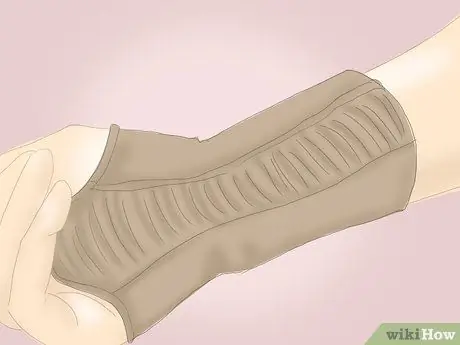
Step 3. Use a wrist brace
Wrapping your wrist with an Ace or compression bandage, gauze, or a simple neoprene wrist brace can help support the joint while allowing you to apply ice more easily. However, the best benefits are psychological. Basically, this brace serves as a reminder not to overuse your wrist for a while.
- Wrap the wrist from the knuckle to the center of the forearm. Wrap the elastic bandage overlapping as you put it on.
- Neoprene bandages, bandages, or supports on the wrist should fit, but not impede blood circulation. Make sure your hands don't turn bluish, feel cold, or tingle.
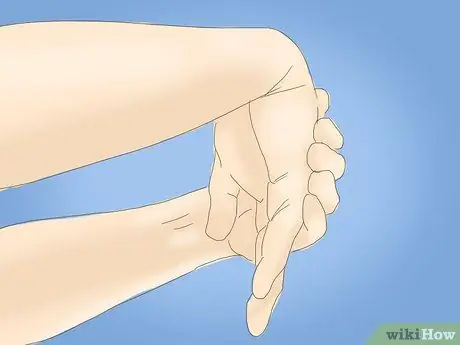
Step 4. Do some light stretching
Once the pain and inflammation has subsided, do some light stretching if your wrist still feels stiff. Light stretching is beneficial for minor sprains or sprains because it can reduce tension, improve blood circulation, and increase flexibility. As a general guide, stretch for about 30 seconds 3-5 times a day until your wrist can move as usual.
- You can stretch both wrists at the same time in a prayer pose with your hands (palms touching each other in front of your face by bending your elbows). Apply pressure to the palm by raising the elbow until the injured wrist is slightly stretched. Consult a doctor, trainer, or physiotherapist for other stretching techniques if necessary.
- Consider applying a hot, moist compress to your wrist before practicing the stretch. This compress will flex your tendons and ligaments.
Part 2 of 3: Treating Moderate Sprains of the Wrist
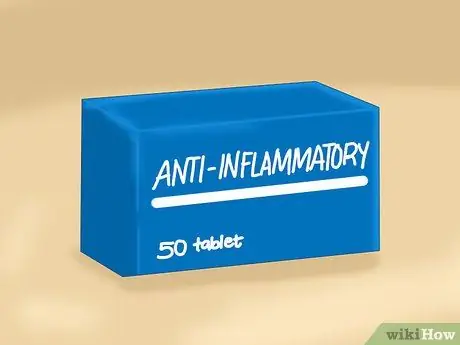
Step 1. Use over-the-counter medications
Non-steroidal anti-inflammatory drugs (NSAIDs) such as ibuprofen, naproxen, or aspirin can be a short-term solution for you to deal with severe pain or inflammation in the wrist. Keep in mind that this medication is harsh on the stomach, kidneys, and liver so it should not be used for more than 2 weeks in a row. Do not give aspirin to children under the age of 18.
- Talk to your doctor before starting any new medication if you have health problems, are taking other medications, or are allergic to certain medications.
- Alternatively, apply a pain relief cream or gel directly to the wrist that hurts.
- Elevating the wrist can also help reduce swelling.
- Moderate wrist sprains, commonly referred to as grade 2 sprains, include severe pain and inflammation, and often bruising from a torn ligament.
- A grade 2 sprain may feel more unstable and make the hand weaker than a grade 1 sprain.
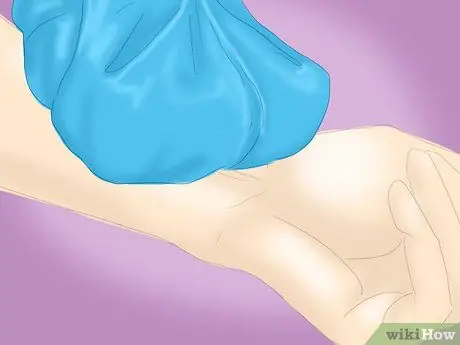
Step 2. Apply ice more often
Moderate sprains or grade 2 sprains cause more severe swelling because the ligament fibers are torn but not to the point of breaking. To fix this, you will need to apply ice more often in addition to using anti-inflammatory drugs. The sooner you apply ice to a grade 2 sprain, the better because the blood vessels will shrink, reducing blood flow and swelling. For more serious sprains, it is best to apply ice for 10-15 minutes every hour for the first day or two. Furthermore, the frequency of treatment can be reduced after the pain and swelling subside.
If ice or gel bags are not available, use frozen vegetable bags from the freezer, frozen vegetable packs such as peas or corn are fine
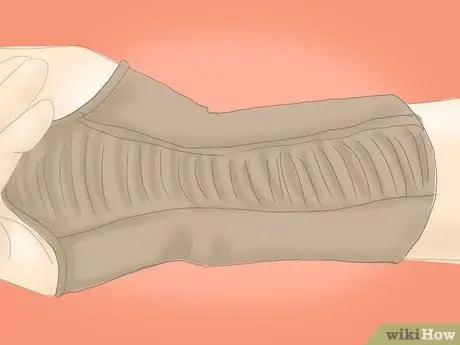
Step 3. Put on a wrist splint or brace
Wrist instability and weakness are more of a concern with a grade 2 sprain, so you should wear support such as a splint or wrist brace. Wrist splints or restraints don't only have a psychological effect because they will hinder movement and provide good support for your hand when you want to use it to do something.
- Consult with your doctor to find out what type of splint or brace is recommended.
- Be sure to keep your wrist in a neutral position when tightening the brace or splint.
- Movement of the wrist with a grade 2 sprain should be limited with a splint or brace for 1-2 weeks which can lead to stiffness and reduced range of motion of the wrist when released.
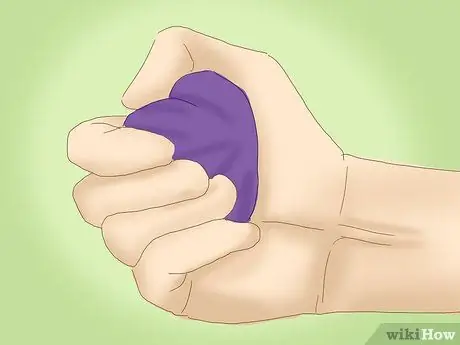
Step 4. Plan rehabilitation therapy
After a grade 2 wrist sprain begins to heal after a few weeks, you may need to undergo rehabilitation therapy to restore strength and mobility. You can do this therapy at home or visit a physiotherapist who will show you specific, targeted strengthening exercises for your hand and wrist.
- To restore strength after your wrist has improved, try squeezing the ball. While extending your arms and pointing your palms up, squeeze a rubber ball (tennis balls work) with your fingers for 30 seconds at a time and repeat 10-20 times a day.
- Other activities that can help restore wrist strength include lifting weights, bowling, playing racquet sports, and gardening (pulling grass, etc.). Just don't start doing this kind of activity until your doctor or therapist allows it.
Part 3 of 3: Seeking Medical Help
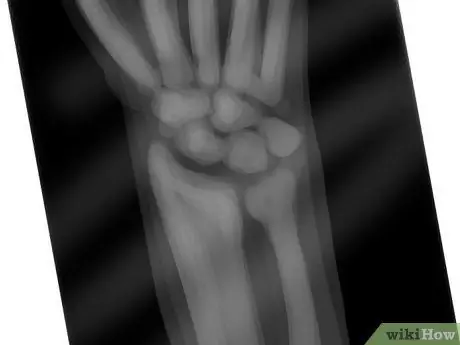
Step 1. Visit a doctor
In cases of severe wrist trauma that results in severe pain, swelling and bruising, and/or loss of hand function, you should visit your family doctor or emergency room immediately for a proper diagnosis. 3rd degree sprains involve broken ligaments that require surgery to restore them. Other serious wrist problems your doctor will examine include fractures, dislocations, arthritis (such as rheumatoid arthritis, or gout), carpal tunnel syndrome, infections, and severe tendonitis.
- X-ray examinations, bone scans, MRI, and nerve conduction are supporting the doctor's diagnosis while examining wrist problems. Your doctor may also order blood tests to confirm that rheumatoid arthritis or gout is not the cause.
- You should also see your doctor if you are still experiencing symptoms after treating a sprained injury at home for more than 2 weeks, or if your symptoms worsen.
- Other symptoms that may indicate a fracture include swelling, bruising, and severe pain, changes in the shape of the hand, and those caused by falls on the wrist and sports injuries.
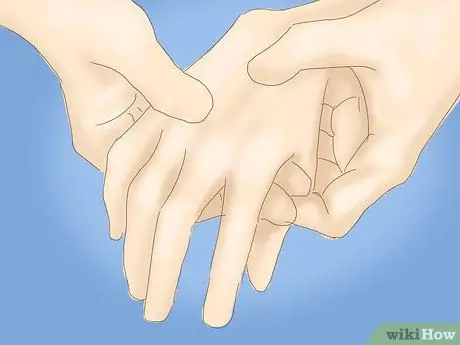
Step 2. Visit a chiropractor or osteopath
Chiropractors and osteopaths are joint specialists who focus on restoring normal range of motion and function to the spine and peripheral joints, including the wrist. If the wrist injury is caused by compression or displacement of the carpal bones, the chiropractor/osteopath will use manual joint manipulation also called "adjustment" to open or reposition the affected joint. Often, you will hear a "pop" or "crack" sound when this action is performed.
- While one action is sometimes enough to relieve wrist pain and restore normal range of motion, you will likely need to undergo several procedures before you feel the results.
- Wrist adjustments are not suitable for fractures, infections, or arthritis.
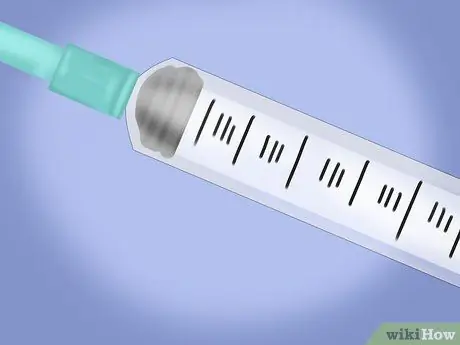
Step 3. Talk about wrist injections with your doctor
Injection of steroid medication near a ligament, tendon, or joint can relieve inflammation quickly, and allow the wrist to function normally without any back pain. Cortisone injection is indicated only for chronic or serious wrist injuries. The most commonly used preparations are prednisolone, dexamethasone, and triamcinolone.
- Potential complications of steroid injection include infection, bleeding, tendon weakening, local muscle atrophy, and nerve irritation/damage.
- If corticosteroid injections fail to resolve wrist problems, you should consider surgery.
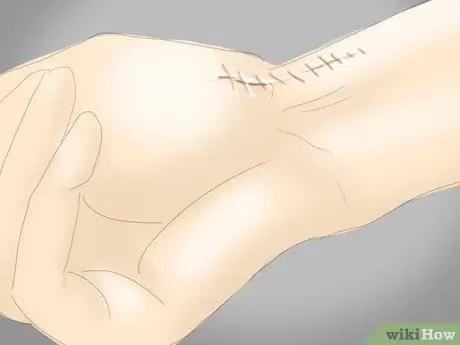
Step 4. Talk about surgery with your doctor
Wrist surgery for chronic pain is a last resort, and should only be considered after other noninvasive therapies have proven ineffective. Except in the case of a 3rd degree sprain which may require the first choice of action is surgery to restore the severed ligament. Wrist surgery involves reattaching the severed carpal bone ligaments, sometimes with pins or metal plates as stabilizers.
- Wrist ligament surgery takes 6-8 weeks to heal. However, several months of rehabilitation therapy may be needed to restore strength and range of motion to normal.
- Complications that may occur in wrist surgery include local infection, allergic reactions to anesthetics, nerve damage, paralysis, and chronic pain/swelling.
Tips
- If you experience an injury or new symptoms that are not mild, you should check with your doctor before starting treatment.
- Chronic and repetitive sprains of the wrist from old ligament injuries that are not treated properly can eventually lead to arthritis.
- Wrist injuries are usually the result of a fall, so be careful when walking on wet or slippery floors.
- Skateboarding is an activity that has a high risk of causing a sprained wrist. So, always wear wrist guards when doing it.






